Themed collection Carbon capture, storage or utilisation – Topic Highlight

Towards an accelerated decarbonization of the chemical industry by electrolysis
Electrochemical technologies support the transition towards carbon-neutral chemical manufacturing and we need new approaches to accelerate electrolysis scale-up.

Energy Adv., 2023,2, 268-279
https://doi.org/10.1039/D2YA00134A
A critical review of technologies, costs, and projects for production of carbon-neutral liquid e-fuels from hydrogen and captured CO2
Hydrogen (H2) production along with CCUS (carbon capture, utilization, and storage) are two key areas for transition to net-zero emission. Carbon-neutral liquid e-fuels produced from H2 and captured CO2 are practical alternatives to fossil fuels.
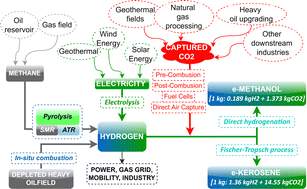
Energy Adv., 2022,1, 580-605
https://doi.org/10.1039/D2YA00173J
Results from the operation of an efficient and flexible large-scale biogas methanation system
This study reports a comprehensive analysis of the operation of a biogas methanation system with a total 240 kW SNG output.
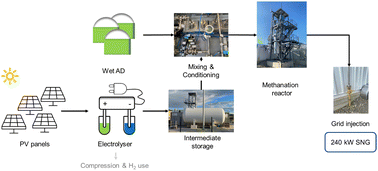
Energy Adv., 2024,3, 131-142
https://doi.org/10.1039/D3YA00436H
Dry reforming of steelworks off-gases in a pilot plant integrated into a steel mill: influence of operating parameters
Next step forward towards green steel! A pilot plant integrated into a steel mill has been operated successfully and shows promising results. This novel, retrofitted process for steel production has the potential to cut global CO2 emissions by 0.5%!
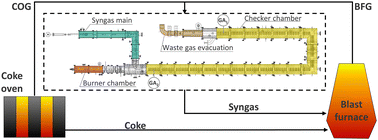
Energy Adv., 2024,3, 123-130
https://doi.org/10.1039/D3YA00227F
Assessing reservoir performance for geologic carbon sequestration in offshore saline reservoirs
Permeability distribution imposes substantial control over CO2 flow path, in situ temperature changes, and fluid pressure propagation in offshore geologic storage of CO2.

Energy Adv., 2023,2, 2069-2084
https://doi.org/10.1039/D3YA00317E
Electrowetting limits electrochemical CO2 reduction in carbon-free gas diffusion electrodes
Electrowetting leads to flooding of silver-based, carbon-free gas diffusion electrodes for CO2 electrolysis.

Energy Adv., 2023,2, 1893-1904
https://doi.org/10.1039/D3YA00285C
Poly(triazine-co-pyrrole)-based conjugated microporous polymers for carbon dioxide capture
Enhancing CO2 capture through conjugated microporous polymers.

Energy Adv., 2023,2, 1127-1133
https://doi.org/10.1039/D2YA00346E
Two-dimensional Ti3C2Tx MXene nanosheets for CO2 electroreduction in aqueous electrolytes
Electrochemical conversion of CO2 to C1 and C2+ chemical synthons using a 2D Ti3C2Tx catalyst in benign aqueous electrolytes.

Energy Adv., 2023,2, 1166-1175
https://doi.org/10.1039/D3YA00117B
Cation synergy in Sr and Al substituted LaMnO3 during solar thermochemical CO2 splitting
The influence of bond polarity on the thermochemical redox properties of a series of cation substituted perovskite oxygen carriers is reported.

Energy Adv., 2023,2, 137-147
https://doi.org/10.1039/D2YA00309K
Brute force determination of the optimum pore sizes for CO2 uptake in turbostratic carbons
The relationship between porosity within a given pore size range, and uptake of CO2 as a function of pressure.
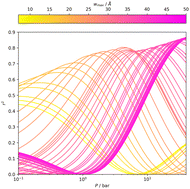
Energy Adv., 2022,1, 1009-1020
https://doi.org/10.1039/D2YA00149G
Predictive energetic tuning of quinoid O-nucleophiles for the electrochemical capture of carbon dioxide
We use quinone reduction potentials to showcase molecularly tunable CO2 binding strengths for a family of electrochemically generated quinoid molecular sorbents. In our study, we find that CO2 binding stoichiometry varies with CO2 concentration.

Energy Adv., 2022,1, 900-907
https://doi.org/10.1039/D2YA00114D
CO2 removal and 1.5 °C: what, when, where, and how?
We investigate how different CDR options—afforestation/reforestation (AR), bioenergy with carbon capture and storage (BECCS), and direct air carbon capture and storage (DACCS)—might be deployed to meet the Paris Agreement's CDR objectives.
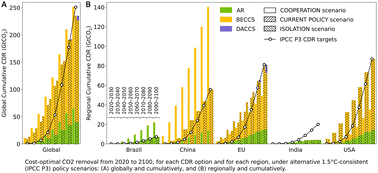
Energy Adv., 2022,1, 524-561
https://doi.org/10.1039/D2YA00108J
Upcycling the carbon emissions from the steel industry into chemicals using three metal oxide loops
A new combined chemical looping process makes use of any gas stream containing CO2 and fuel to produce carbon monoxide without external energy input. Carbon monoxide can be used for producing a variety of carbon-based products.

Energy Adv., 2022,1, 367-384
https://doi.org/10.1039/D2YA00018K
Imidazolium and picolinium-based electrolytes for electrochemical reduction of CO2 at high pressure
Ionic liquid-based aqueous electrolytes with reduced IL content for coupling CO2 capture and electrochemical reduction.

Energy Adv., 2022,1, 277-286
https://doi.org/10.1039/D2YA00001F
Direct and mild non-hydroxide activation of biomass to carbons with enhanced CO2 storage capacity
Direct activation of biomass, via a simple and lower cost one-step process, with potassium oxalate as a mild and less corrosive agent, yields activated carbon with properties and CO2 uptake comparable or superior to conventionally prepared activated carbons.

Energy Adv., 2022,1, 216-224
https://doi.org/10.1039/D1YA00085C
About this collection
Energy Advances features cutting-edge science at the forefront of energy technology with a particular focus on emerging materials and methods. This collection highlights some of our recent publications in carbon capture, storage and utilisation (CCUS).
Our multidisciplinary journal publishes research across a broad scope of energy topics. To contribute your work, please visit our submission platform.